Ankle orthosis with additional straps F 2223
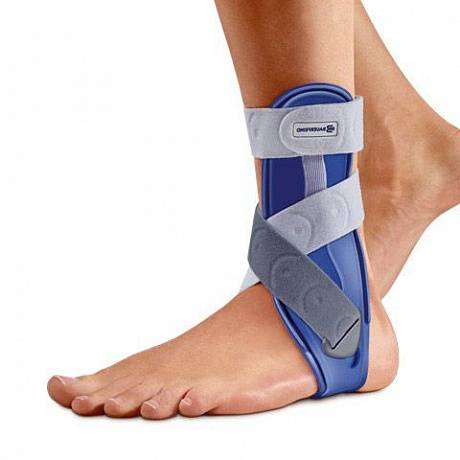
- Ankle bandage
- Elbow splints
- Symptoms of an ankle fracture
- Types of fixators
- Types of ankle orthoses
- What materials are used to make ankle orthoses?
- Can wearing an ankle brace cause muscle loss?
- Which type of orthosis is better?
- Types of ankle braces by function
- Adjustment levels of the ankle support
- Correct wearing of an ankle brace
- Why is the orthosis necessary?
- Types of ankle orthoses
- Overview of the best ankle braces
- Immobilizing ankle orthosis EST-088
- Rotary ankle support with variable angle FS 2952
- Ankle orthosis with lacing and stiffening ribs AS – ST/H
- Why a bandage is important
- How to wear and care for a bandage
Ankle bandage
Ankle orthoses are characterized by their simple design. This makes them comfortable to wear even for patients with severely limited range of motion.
To increase comfort, first put a cotton sock over your foot and then place the splint over the orthosis. Soft and semi-rigid products can be worn like a stocking. They can be worn continuously for 6 hours. After this time they should be undressed for 30 minutes. The way the orthosis is worn is determined by the doctor! Some models require treatment of the skin with an antiseptic. Therefore, always follow the instructions for use.
If necessary, the wearing time of a rigid structure can be extended to 8 hours. However, the break time after this time is also around 30 minutes.
For proper self-use of the device, a doctor should be consulted in advance. He will help you determine the correct pressure on the leg, which will not cause disruptions in the nutrition of the tissues and at the same time properly fix the limb. This is especially true for rigid structures.
Soft items can be hand washed. However, you need a flat surface to dry. Drying with additional heating is prohibited: on towel racks and radiators.
Rigid garments do not need to be washed; wiping with water and/or antiseptic solution is sufficient.
Elbow splints
Elbow splints are used for the following diseases, among others
- Intra-articular fractures of the elbow joint;
- Non-displaced fractures of the humerus;
- contortions;
- Fractures of the forearm (upper 2/3);
- rehabilitation after operations;
- Inflammatory and degenerative joint diseases.
The product can be used for a long period of time without restrictions. The soft structure can be removed at night to avoid atrophy. Rigid structures can be permanently supported if necessary.
In cases of swelling or other situations, some types of orthoses can be remodeled after initial heating in hot water.
Symptoms of an ankle fracture
- Inability to support the leg, leading to difficulty walking;
- severe pain at the site of injury;
- Swelling at the fracture site.
The fracture makes it impossible to put any weight on the injured limb. The fracture can be diagnosed using x-rays; If the x-ray is not informative, a computer tomography (CT) is indicated. In a closed fracture, the bone is embedded in the soft tissue and a splint is required. Externally, the deformation of the shinbone is visible. In an open fracture, the bone compromises the integrity of the skin, making it visible from the outside.
Types of fixators
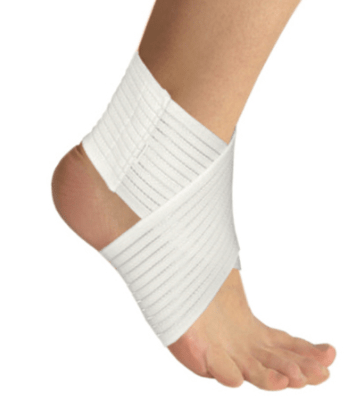
Elastic – are not used to treat fractures, but can be used as a preventive measure during the rehabilitation period after bone fragments have healed.
Elastic orthoses (bandages) are made from dense, embossed fabric. They have a compressing, supporting, massaging and warming effect. Because fabric bandages are quite thin, they can be worn with shoes and are not visible under clothing.

Semi-rigid bandages – are intended for partially restricting mobility and preventing stress injuries. Their design includes stiffening ribs made of plastic or metal. They are attached with laces, Velcro and zippers. Wearing a semi-rigid orthosis requires open-toed shoes or 1-2 sizes larger than usual.

Rigid – replaces a plaster cast. Used to treat fractures of all degrees of severity. Used for dislocation injuries after surgery. Typically, rigid insoles are shaped like a shoe and completely cover the foot and shin up to the knee. They are made of plastic or metal with elastic inserts and an inner layer of fabric. A system of fasteners and straps allows it to be fixed to the limb. No shoes are required for such an orthosis, but they can be worn if necessary.
Rigid orthoses include products made from the low-temperature material ORDEKT. They keep the joint stable and do not change shape throughout their lifespan. Plastic orthoses completely replace a plaster cast, are easy to put on and have a short curing time.
Types of ankle orthoses
Divided according to their properties: strength and rigidity of fixation.
- Light immobilization (also called soft immobilization) – soft immobilization of the joint, used for therapeutic purposes in minor injuries, arthrosis, to immobilize the foot, for prophylactic purposes, to relieve mild swelling, during sports activities.
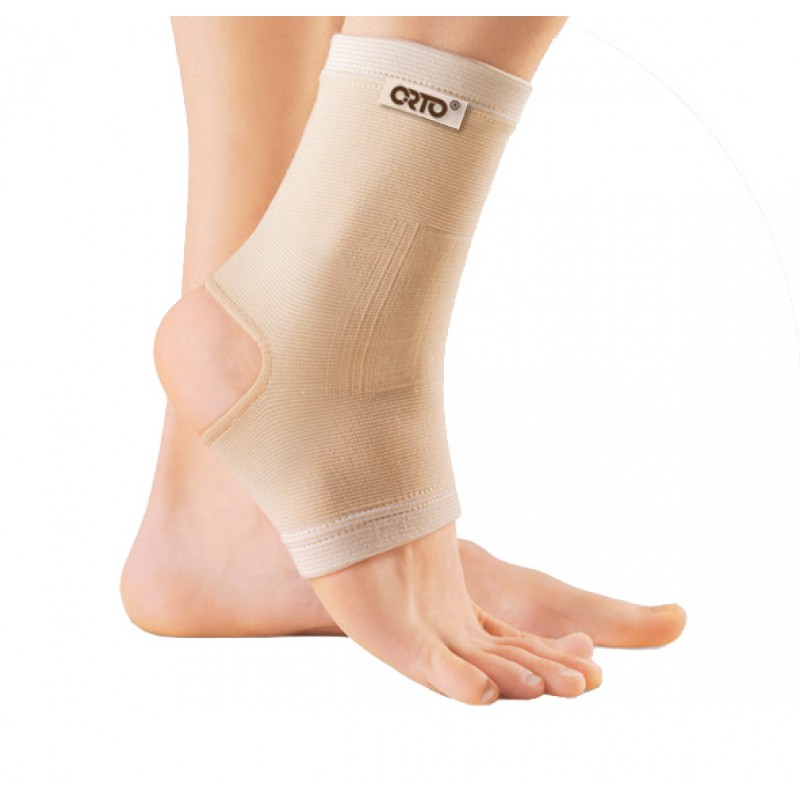
- Medium immobilization (semi-rigid joint immobilization) – strong immobilization of the ankle and foot thanks to various insoles (plastic, metal). Suitable for bruises, sprains, during fracture rehabilitation, after removing the plaster cast. To prevent fractures during dynamic sports.
- Rigid immobilization – used in severe injuries and fractures as an alternative to plaster casts, as it ensures complete immobilization (fixation) of the joint tissue.
- There are also special orthoses for the ankle joint that are used in the event of a foot drop, such as the so-called foot immobilization (foot support) or the Swedish orthosis. It is prescribed for traumatic nerve injuries, joint injuries and ankle ligament injuries. After paralysis, stroke and cerebral palsy (CP). The orthosis fixes the hallux valgus foot in a physiological position, allows independent movement and prevents contractures (stiffening) in the ankle joint.
- A derotation shoe is a plastic ankle brace used for femoral neck fractures to prevent rotation (rotation) of the lower extremity so that the femoral neck fracture can heal properly.
What materials are used to make ankle orthoses?
Various materials are used to make this orthopedic device. They should be selected depending on the function that the orthosis is supposed to fulfill.
If a person is prone to allergic reactions, the choice should fall on products that contain a high proportion of Cotton Ingredient.
To reduce pain and swelling and retain heat, select products Neoprene.
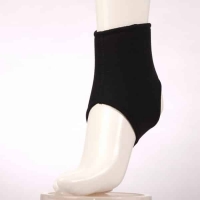
Ankle orthosis made of neoprene F 2221
Models with silicone inserts, like the silicone models, provide firm compression and fixation and compensate for irregularities in the joint configuration. If the foot is under heavy strain, e.g. B. during sports or during strenuous physical exertion, an ankle orthosis is particularly recommended.
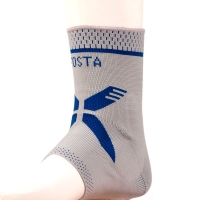
Ankle orthosis with silicone insertsF 2602
Velcro or webbing straps increase the stability of flexible models.
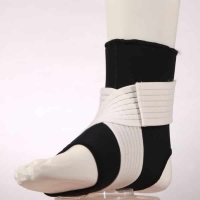
Ankle orthosis with additional strapsF 2223
Don't be afraid of synthetic fabrics. Modern fabrics are manufactured using the latest technology and are 'breathable'.
Can wearing an ankle brace cause muscle loss?
There are no studies to support the claim that wearing a brace causes muscle loss.
However, the use of rigid orthoses is not advisable in the long term unless the structure is subjected to severe mechanical stress or there is chronic mechanical instability.
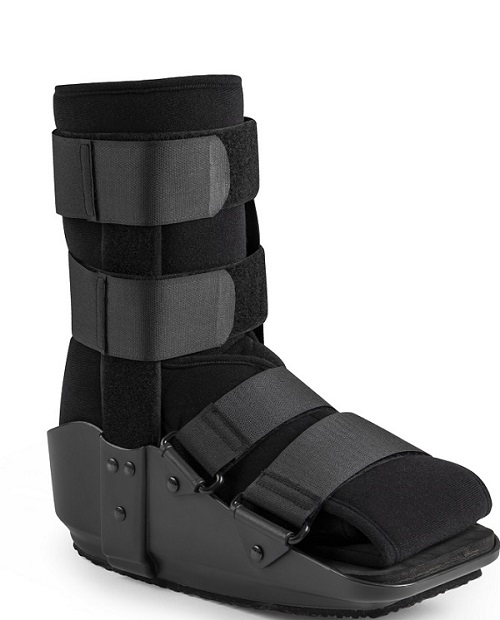
However, it is important to always individually analyze the degree of stress on the ligament, the development during recovery and the characteristics of the patient in order to decide whether an orthosis should be worn.
Which type of orthosis is better?
The type of orthosis for an ankle sprain must be prescribed by the doctor.
It is important to choose the size of the orthosis. The wrong size ankle brace not only prevents sprains but can also damage the ankle.
It is therefore advisable to try on an ankle orthosis beforehand. In Aesculap orthopedic stores you can try on orthoses and choose the right size.
In our salons you will find a large selection of ankle supports:
- Orthoses for immobilizing the ankle joint;
- variable angle rotation orthoses;
- Support orthoses with lacing and support ribs;
- elastic bandages and ankle stoppers.
If your doctor has prescribed an ankle brace for a sprain, please visit Aesculap orthopedic technology stores.
Types of ankle braces by function
- Pressure-relieving ankle brace - to reduce pressure on the joint without restricting mobility;
- corrective – to gradually eliminate or prevent the development of deformities of the joint and distal region;
- immobilizing – to immobilize the joint after an injury or in the event of acute inflammation;
- dynamic – to restore joint mobility in the event of instability of the musculoskeletal system, e.g. B. after a stroke.
The manufacturers of the ankle orthoses available in our GLAORT shop always state the function and purpose of the product. However, the final decision must be made by a professional. You can find a catalog of ankle orthoses at this link.
Adjustment levels of the ankle support
Lightweight - elastic bandages are used without ribs or inserts. Products in this category are used for bruises, sprains and also in sports to relieve pressure on the joint. The group of light immobilization also includes so-called therapeutic bandages, the elastic fabric of which is soaked in medication to accelerate joint regeneration or to disinfect wounds. The elastic bandage is inconspicuous under clothing, does not require a change of footwear and can be worn 24 hours a day, even by children.
Medium/Moderate – achieved by adding stiffening ribs (metal, plastic) to the elastic material. A brace with this level of stiffening is essential for people with chronic ankle instability and is also used for moderate injuries and during the rehabilitation period after surgery. The characteristic feature is the combination of massage and compression effects (warming), which promotes the regeneration of the joint.
Strong/semi-rigid – used as an alternative to a cast in injuries with damaged ligaments, pronounced instability of the ankle joint, flaccid paralysis of the foot and other pathologies. The product is a strong, flexible, woven shoe with stiffening ribs and additional fixation inserts. With the help of shoelaces or Velcro fasteners, the optimal fastening parameters can be selected and changed as required.
Full/rigid – for complete immobilization of the foot in the event of ankle fractures. The product consists of a medical plastic frame and rigid inserts to securely fix the joint. Since this is a product that is intended to be worn around the clock, manufacturers pay particular attention to the quality of the materials that come into contact with the skin - this excludes pathogenic flora and provides the foot with maximum moisture transport and ventilation Comfort offered.
Correct wearing of an ankle brace
Let's start with how to put on the orthosis. This is relatively easy. Most ankle braces are easy to put on and take off. They can be worn barefoot or with thin socks.
It is not recommended to wear the brace if it is already on. Take breaks every six hours and ventilate the skin.
You can receive detailed advice on wearing an ankle orthosis from an experienced specialist.
Why is the orthosis necessary?
- Immobilization of the ankle joint for various diseases of the musculoskeletal system.
- Prevention of ankle injuries in people who play sports, work in tourism or lead an active lifestyle and are often exposed to various stresses, etc.
- Prevention of inflammation and injury in patients suffering from obesity.
- Prevention of bone deformities in people prone to such pathological changes.
- Prevention of inflammation and injury in people whose limbs are damaged by other factors, such as: B. professional activity, are heavily burdened.
- Relief from painful sensations.
- Acceleration of wound healing times. According to practical studies, the use of orthoses has shown that damaged tissue regenerates relatively quickly.
Orthoses are prescribed by medical specialists for a number of specific cases, namely:
- Certain inflammatory and degenerative diseases (particularly arthritis and osteoarthritis);
- fractures, subluxations and dislocations;
- instability of the joints;
- Congenital anomalies, rickets in children and other pediatric pathologies;
- the need for injury prevention in obese patients and athletes;
- etc.
Below we differentiate between the main types of orthoses according to their stiffness:
- Soft products (with a mild to moderate degree of immobilization). Soft orthotics are made of soft materials (fabric, etc.) and are therefore more like socks. Their use is mainly limited to the prevention and treatment of ankle injuries. This type of orthosis is the easiest to use and care for (it is characterized by being easy to put on, wash and wear with shoes).
- Semi-rigid type (with fixed fixation). Plastic or metal inserts increase the degree of fixation of these devices, which can easily replace plaster. Semi-rigid orthoses are usually equipped with laces or straps.
- Rigid braces (with 100%iger fixation). These orthoses have the highest degree of fixation and are equipped with rigid inserts or splints. In most cases they are used for joint problems or fractures.
Based on the diagnosis and the individual characteristics of the patient (weight and age), the orthosis is prescribed by the doctor. The patient should not only adhere to the recommendations of the treating doctor. He should be aware that the size of the orthosis depends on the characteristics of the foot, ankle, shin and ankle joint.
It should also be taken into account that the effectiveness of the treatment is directly influenced by the optimal size of the orthosis. If the product is the wrong size, it will not have the desired effect and may actually make the problem worse.
The highly qualified professionals in our showroom will be happy to give you practical advice on how to determine the size of the orthosis.
Types of ankle orthoses
- rigid orthoses with strong fixation that hold the joint in a fixed position and are intended for rehabilitation after fractures and operations;
- semi-rigid, moderately rigid orthoses, the strength of which can be adjusted depending on the condition of the joint and the phase of treatment;
- soft orthoses or supports worn under footwear to prevent injuries and treat minor joint damage.
The ankle orthoses are also designed differently. Your doctor may prescribe a specific type of orthosis depending on your condition:
- an adjustable orthosis;
- an immobilizing orthosis;
- a derotation orthosis;
- Ankle brace with lacing and support ribs;
- split ankle orthosis.
Overview of the best ankle braces
Here you will find a small overview of the ankle orthoses from the Aesculap range in the showroom.
Immobilizing ankle orthosis EST-088
The model has a stable construction that immobilizes the joint at the desired height.

Depending on the pathology, a rigid orthosis allows the leg to be completely immobilized until tissue integrity is restored.
A comfortable alternative to a plaster cast. Can be used instead of a cast for foot ulcers.
Rotary ankle support with variable angle FS 2952
The variable angle rotation ankle brace is used in the rehabilitation of bedridden patients. Their main function is to limit rotation in the hip joint.

The model can be used for rehabilitation after prosthesis or other hip surgery.
The derotation splint is recommended for the rehabilitation of immobilized patients with paralysis of the lower limbs or parts thereof, including after strokes.
Ankle orthosis with lacing and stiffening ribs AS – ST/H
Indications: chronic instability of the ankle joint. Sprains and strains. Rehabilitation after injuries and operations.

Why a bandage is important
A bandage is a good alternative to plaster casts, splints and other immobilization devices. They ensure complete immobilization of the leg and allow at least minimal physical activity.
The benefit of a bandage for ankle injuries is undeniable, because even small bruises require special attention, otherwise a minor injury can quickly develop into a major ailment. With a bandage, the leg can recover quickly and get back into shape.
For athletes, dancers and gymnasts, soft bandages help prevent muscle and ligament strains. During regular exercise, the ankle is put under the greatest strain, the ligaments wear out quickly and become extremely susceptible to injury. That's why experts keep talking about the importance of preventive measures.
How to wear and care for a bandage
A padded bandage does not require any special care; it should be washed and cleaned regularly. Soft pads can be washed by hand or in the washing machine; Sanitary pads with inserts can only be hand washed. The soft bandage is almost invisible in everyday clothing and can be worn with shoes.
It is recommended to initially wear the bandage for 1-2 hours and then take a break. Once the foot has gotten used to the new product, the length of time it is worn can be gradually increased. It is advisable to check the skin under the bandage regularly to ensure that there is no irritation or redness.
The bandage should be removed every six hours to allow the skin to recover. It is advisable to use a special antiseptic to minimize possible redness.
Please note that even a soft prophylactic bandage should only be used after consulting your doctor. Only he or she can tell you which model you should choose and what level of immobilization is required in your specific case.
Read more:- What are knee braces?.
- ankle braces for children.
- ankle orthoses.
- What is an orthosis?.
- Turbocast footprints.
- tunics.
- knee brace.
- What is a knee brace?.
